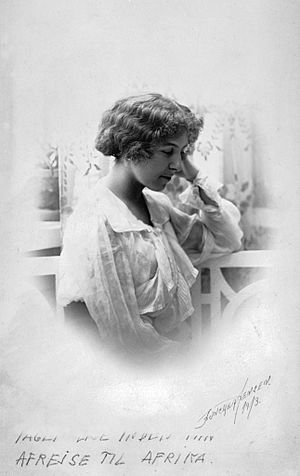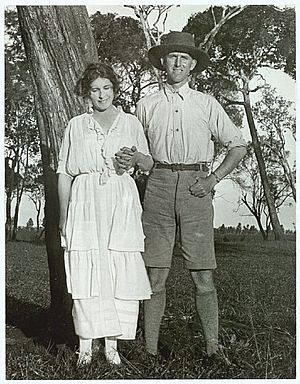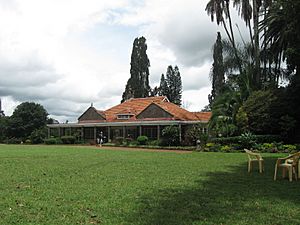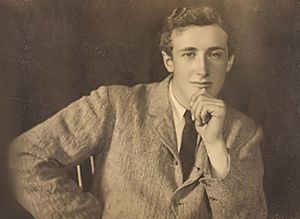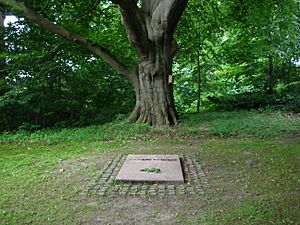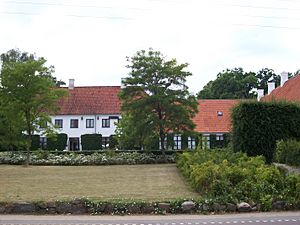Karen Blixen facts for kids
Quick facts for kids
Karen Blixen
|
|
|---|---|

Blixen in 1957
|
|
| Born | Karen Christenze Dinesen 17 April 1885 Rungsted, Zealand, Denmark |
| Died | 7 September 1962 (aged 77) Rungsted, Zealand, Denmark |
| Pen name | Isak Dinesen, Tania Blixen |
| Occupation | Writer |
| Language | English, Danish |
| Notable works | Out of Africa, Seven Gothic Tales, Shadows on the Grass, Babette's Feast |
| Spouse |
Bror von Blixen-Finecke
(m. 1914; div. 1925) |
| Partner | Denys Finch Hatton |
| Relatives | Ellen Dahl (sister) Thomas Dinesen (brother) Andreas Nicolai Hansen (great-grandfather) Mary Westenholz (aunt) |
Baroness Karen Christenze von Blixen-Finecke (born Dinesen; 17 April 1885 – 7 September 1962) was a famous Danish author. She wrote books in both Danish and English. She is also known by her pen names, like Isak Dinesen (used in English-speaking countries) and Tania Blixen (used in German-speaking countries).
Karen Blixen is best known for her book Out of Africa. This book shares stories about her life when she lived in Kenya, Africa. Another famous story of hers is Babette's Feast. Both of these stories were made into movies that won Academy Awards. In Denmark, she is also well-known for her book Seven Gothic Tales. Later, she wrote other stories like Winter’s Tales (1942) and Last Tales (1957).
Blixen was thought of many times for the Nobel Prize in Literature. However, she never received it. Reports from Denmark say that the judges were worried about favoring writers from Scandinavian countries.
Contents
Biography
Growing Up and School
Karen Dinesen was born in a large house called Rungstedlund. This house is north of Copenhagen, Denmark. Her father, Wilhelm Dinesen, was a writer and an army officer. Her mother, Ingeborg Westenholz, came from a wealthy merchant family. Karen was the second oldest of five children. Her younger brother, Thomas Dinesen, later won a special medal for bravery in the First World War. Friends called Karen "Tanne."
Karen's early years were shaped by her father's love for the outdoors and hunting. He also wrote books about his adventures. Her father died when Karen was nine years old. After his death, her life at Rungstedlund changed. She was taught at home by her grandmother and her aunt, Mary Westenholz. Her aunt had a big influence on her. They often talked about women's rights and relationships.
When she was young, Karen spent time at her mother's family home and also visited her father's family estate. She missed the freedom she had when her father was alive. She found joy in telling exciting stories to her younger sister. These stories were inspired by Danish folk tales. In 1905, she wrote a story called Grjotgard Ålvesøn og Aud, which showed her writing talent. She also published stories in Danish magazines using the name Osceola, which was her father's dog's name.
In 1898, Karen and her two sisters lived in Switzerland for a year. There, she learned to speak French. Later, she studied art in Copenhagen from 1902 to 1906. She also traveled to Paris, London, and Rome to study art.
Karen often spent holidays with her cousins, the Blixen-Fineckes, in Sweden. She first liked Hans, but he didn't feel the same way. So, she decided to marry his twin brother, Bror von Blixen-Finecke. They announced their engagement in December 1912. Since they both found it hard to settle in Denmark, their family suggested they move abroad. Their uncle, Aage Westenholz, suggested they go to Kenya to start a coffee farm. He and Karen's mother invested money in the farm. Bror went to Kenya in early 1913, and Karen followed him in December.
Life in Kenya (1914–1931)
Karen arrived in Kenya, which was then called British East Africa. She and Bror married in Mombasa on January 14, 1914. After her marriage, she was known as Baroness Blixen. She used this title until her ex-husband remarried in 1929. Karen and Bror first planned to raise cattle on their farm. But they soon decided that growing coffee would make more money. The Karen Coffee Company was started by their uncle, Aage Westenholz. He named the company after his own daughter, Karen, not Karen Blixen. The couple set up their first farm, Mbagathi.
During the First World War, Bror helped with patrols along Kenya's border. Karen helped by moving supplies. The war made it hard to find workers and supplies. In 1916, the Karen Coffee Company bought a bigger farm called Mbogani. It was near the Ngong Hills, southwest of Nairobi. The property was about 6,000 acres. About 600 acres were for coffee plants. Local people used 3,400 acres for grazing. The rest was untouched forest.
The land was not ideal for growing coffee because it was too high up. The couple hired local workers, mostly Kikuyu people who already lived on the land. Other workers included Wakamba, Kavirondo, Swahili, and Masai. At first, Bror managed the farm. But he soon preferred to go on safaris and left Karen to run the farm. For the first time, Karen used English every day.
On her farm, she also helped care for sick local people. She returned to Denmark in June 1915 for a visit.
In 1918, Karen and Bror met Denys Finch Hatton, an English big game hunter. Their marriage faced problems by 1919. Bror was removed as the farm manager by their uncle. Karen took over managing the farm in 1921.
After the war, Finch Hatton became good friends with Karen and Bror. He often traveled between Africa and England. He visited Karen sometimes. Karen and Bror separated in 1921. After her separation, Karen and Finch Hatton became very close friends. This friendship grew into a long-term partnership. Karen wrote to her brother in 1924 that she felt connected to Denys forever. However, their relationship was not always easy. Karen became very dependent on Finch Hatton, who loved his independence.
Karen and Bror officially divorced in 1925. Finch Hatton moved into Karen's house. He used her farmhouse as his home base from 1926 to 1931. He also started leading safaris for wealthy people. One of his clients was Edward, Prince of Wales. Finch Hatton died in a plane crash in March 1931. Karen wrote about their last goodbye.
She wrote: "When he had started in his car for the aerodrome in Nairobi, and had turned down the drive, he came back to look for a volume of poems... He stood with one foot on the running-board of the car, and a finger in the book, reading out to me a poem we had been discussing. ‘Here are your grey geese,’ he said."
At the same time, the coffee farm failed. This was due to poor management, the farm's high location, dry weather, and falling coffee prices. The worldwide economic depression also played a part. Blixen had to give up her estate. Her family's company sold the land. Blixen returned to Denmark in August 1931 to live with her mother. During the Second World War, she helped Jewish people escape from German-occupied Denmark. She stayed at Rungstedlund for the rest of her life.
Life as a Writer

While still in Kenya, Blixen wrote to her brother Thomas. She said she had started writing a book in English because she thought it would be more successful. When she returned to Denmark at age 46, she continued writing seriously. Her first book, Seven Gothic Tales, was finished in 1933. It was hard to find a publisher. The book was published in the United States in 1934 under the name Isak Dinesen. It became very popular and sold many copies. This first book was mysterious and symbolic. It became well-known in the United States. Later, it was published in the United Kingdom and Denmark. Blixen translated the book into Danish herself. She wanted it to feel like an original Danish book, not just a translation. Danish critics were not very excited about the book. They were annoyed that it was published abroad first. After this, Blixen always published her books in Danish first, or at the same time in Danish and English.
Her second book, Out of Africa, was published in 1937. It is now her most famous work. Its success made her very well-known. This time, Blixen published the book first in Denmark and the United Kingdom, then in the United States. It was chosen by a book club, which helped it sell even more. This also made people interested in Seven Gothic Tales again. In 1939, she won a Danish award for women in the arts. Some critics later discussed her views on colonialism. However, Danish scholars often saw her as an outsider, a Dane, and a woman. They found it more complex to judge her personally than to just look at her work. Some critics thought she showed colonial attitudes, but others also saw her understanding of colonial problems and her respect for African people.
Five years after Out of Africa, Blixen published Winter's Tales (1942). These stories were different from her earlier Gothic works. They showed the tough times of war, but also courage, pride, and hope. The stories explored ideas like shame versus pride, and freedom versus being trapped. Because of the war, she had to be clever to get her book published. She traveled to Stockholm to meet with embassy staff. After the war, she received letters from American soldiers who had read her stories.
Blixen worked on a novel called Albondocani for many years. She also worked on several other collections of stories at the same time. Most of her stories from the 1940s and 1950s used a traditional style. They mixed Gothic themes with myths and magic. This helped her explore ideas about identity and life's meaning. Most of these stories were set in the 1800s or earlier. Blixen said she wanted to show a spirit that no longer existed in modern times. Her stories were like a mix of clever illusions and romantic ideas. She knew what her readers liked. She wrote her English stories in a more direct way. Her Danish stories used an older writing style that she thought Danes would prefer.
During World War II, when Germany occupied Denmark, Blixen wrote her only full-length novel. It was called The Angelic Avengers. She used a French pen name, Pierre Andrezel. She said it was a translation of a French book. The book was published in 1944. The difficult experiences of the young heroines in the book have been seen as a symbol of Nazism. But Blixen said the novel was a way for her to escape the feeling of being trapped by the war. In 1956, she finally said that she was the author of the novel.
A collection of stories called Last Tales was published in 1957. Then, Anecdotes of Destiny came out in 1958. Last Tales included stories that Blixen had planned for Albondocani. Blixen's ideas about storytelling are shown in stories like "The Blank Page." Her tales often had hidden meanings. She mixed unclear references with clear observations. Her writing was not just telling stories. It was a complex mix of clues and double meanings. This made readers think and figure out her message. For Blixen, stories were very important for expressing ideas. They shared experiences and showed what was possible.
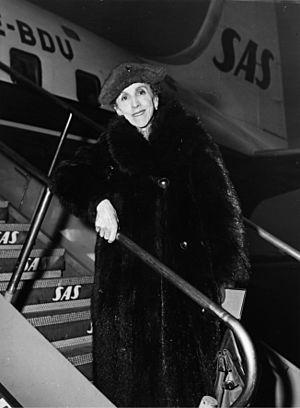
Blixen wanted Anecdotes of Destiny to be part of Last Tales. But she decided to publish it as a separate book. The most famous story from Anecdotes is "Babette's Feast". It is about a chef who spends all her lottery winnings to make one amazing meal. This story was made into a film in 1987. The film won an Oscar for Best Foreign Film in 1988.
In 1959, Blixen visited the United States. She stayed from January to April. She was there to make educational films and have discussions. But she also wanted to have fun. She was featured in Life Magazine. She met many famous people, including John Steinbeck and Maria Callas. She even met Marilyn Monroe and Arthur Miller. During her trip, Blixen acted like a private, unique artist. She was reported to be very thin and ill. She even received special medical treatments.
After returning to Denmark, Blixen kept working, even though she was very sick. She finished her African stories, Shadows on the Grass, in 1960. This was the last of her works published while she was alive. It was chosen by a book club for the fifth time. Shadows is a memoir about her time in Africa. It explores how people see each other. The book has four stories. One focuses on her Somali helper, Farah. Another talks about the importance of symbols. A third describes medical issues in her community. The last one shares her feelings of loneliness after leaving Africa.
Death
Karen Blixen died in 1962 at her family's estate, Rungstedlund. She was 77 years old.
Works Published After Her Death
Some of Blixen's books were published after she died. These include Ehrengard (1962) and Carnival: Entertainments and Posthumous Tales (1977). In the late 1960s, filmmaker Orson Welles planned to make movies based on some of Dinesen's stories. One of his films, The Immortal Story, was released in 1968.
Legacy
Awards and Honors
Karen Blixen received many awards for her writing. She won the Danish Holberg Medal in 1949. She also received the Ingenio et Arti medal in 1952. She was given the first Hans Christian Andersen Scholarship in 1955.
Many people believe Blixen should have won the Nobel Prize in Literature. Peter Englund, from the Swedish Academy, said it was a "mistake" that she didn't win in the 1930s. When Ernest Hemingway won the prize in 1954, he said Blixen deserved it more than he did. In 1961, she was close to winning, coming in third place. In 2012, old Nobel records were opened. They showed that Blixen was considered for the 1962 Nobel Prize. However, she passed away in September of that year, making her ineligible.
Karen Blixen's former secretary, Clara Svendsen, wrote a book about her in 1974. It shared personal stories about Blixen's life. Blixen's great-nephew, Anders Westenholz, also wrote two books about her.
Karen Blixen's picture was on the front of the Danish 50-krone banknote from 1999 to 2005. She also appeared on Danish postage stamps in 1980 and 1996. An asteroid, 3318 Blixen, was named after her on her 100th birthday.
On April 17, 2010, Google celebrated her 125th birthday with a special Google Doodle.
Rungstedlund Museum
Blixen lived most of her life at her family's estate, Rungstedlund. Her father bought the property in 1879. It is about 24 km north of Copenhagen. The oldest parts of the estate date back to 1680. It used to be an inn and a farm. Blixen did most of her writing in a room named Ewald's Room.
In the 1940s, Blixen thought about selling the estate because it was expensive to keep. But the house became a special place for young writers and thinkers. They used the house as a place to meet and discuss ideas. This continued until 1991. The house was fixed up between 1958 and 1960. Part of the estate was set aside as a bird sanctuary. After it was restored, the property was given to the Danish Literary Academy. It is now managed by the Rungstedlund Foundation, which Blixen and her siblings started. It opened to the public as a museum in 1991.
Karen Blixen Museum, Nairobi
When Blixen returned to Denmark in 1931, she sold her property in Kenya. The new owner divided the land into smaller pieces. The area in Nairobi where Blixen farmed coffee is now a suburb called Karen. Blixen herself wrote that the area was "named after me." The company that owned Blixen's farm was called the "Karen Coffee Company." The chairman, her uncle Aage Westenholz, named it after his own daughter, Karen. However, the developer of the suburb named the district after the famous author, Karen Blixen.
The original farmhouse where Blixen lived was bought by the Danish government. They gave it to the Kenyan government in 1964 as a gift for their independence. A college was set up there. When the movie Out of Africa was made in 1985, the college became part of the National Museums of Kenya. A year later, the Karen Blixen Museum opened. It has many of Blixen's original furniture pieces. The museum house is an important cultural landmark. It is known for its connection to Blixen and for showing the European settlement in Kenya. It also has a special architectural style from the late 1800s.
Works
The Royal Danish Library has many of Karen Blixen's unpublished poems, plays, and short stories. She wrote these before she got married and moved to Africa. When she was in her early twenties, she decided to publish some of her short stories. She used the pen name Osceola.
Some of her works were published after her death. These include stories that were taken out of earlier collections and essays she wrote.
- Eneboerne (The Hermits), August 1907 (published in Danish under Osceola)
- Pløjeren (The Ploughman), October 1907 (published in Danish under Osceola)
- Familien de Cats (The de Cats Family), January 1909 (published in Danish under Osceola)
- Sandhedens hævn – En marionetkomedie (The Revenge of Truth: A Marionette Comedy), May 1926 (published in Danish under Karen Blixen-Finecke)
- Seven Gothic Tales (1934 in the US, 1935 in Denmark)
- Out of Africa (1937 in Denmark and England, 1938 in the US)
- Winter's Tales (1942)
- The Angelic Avengers (1946)
- Last Tales (1957)
- Anecdotes of Destiny (1958) (includes Babette's Feast)
- Shadows on the Grass (1960 in England and Denmark, 1961 in the US)
- Ehrengard (published after her death in 1963, US)
- Carnival: Entertainments and Posthumous Tales (published after her death in 1977, US)
- Daguerreotypes and Other Essays (published after her death in 1979, England and US)
- On Modern Marriage and Other Observations (published after her death in 1986, US)
- Letters from Africa, 1914–1931 (published after her death in 1981, US)
- Karen Blixen in Danmark: Breve 1931–1962 (published after her death in 1996, Denmark)
- Karen Blixen i Afrika. En brevsamling, 1914–31 i IV bind (published after her death in 2013, Denmark)
Images for kids
See also
 In Spanish: Karen Blixen para niños
In Spanish: Karen Blixen para niños


